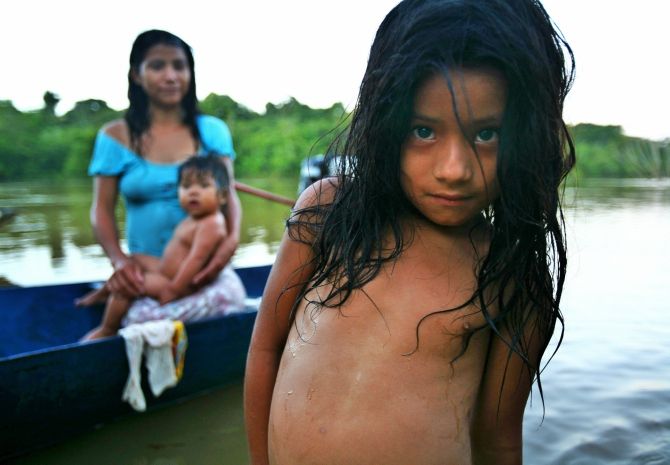But it's a journey of a lifetime, says Kalpana Sunder.

Photograph: Brent Stirton/Getty Images.
There is no road to Iquitos.
The town that leads to the Peruvian Amazon is connected to the world only by boat or air.
And I almost do not make it. The first flight that I boarded was routed back to Lima because of a brewing tropical storm. But the next day I get lucky and land here before my five-day cruise down the legendary river.
Iquitos was founded in 1754 by Jesuits who converted the indigenous people and improved their avenues of livelihood.
By the late 1800s, the town became famous as a rubber boomtown, with rich and ruthless rubber barons filling their mansions with French furniture and tiles from Portugal and Spain.
'They committed terrible atrocities against the rubber tappers,' says our guide, Juan Tejada.
But the town went from boom to bust when rubber seedlings were smuggled out of here and into Asia. Though it revived somewhat with oil exploration in the 1920s, terrorism in the 1990s put a temporary stop to tourism.
Today, Iquitos is the embarkation point for Amazon cruises that take you into places of rich biodiversity such as the Pacaya-Samiria National Park, rife with pink dolphins, sloths and a zillion bird species.
It's also the transport hub of the region for the communities that live along the banks of the mighty river.
The town is at first glance urban chaos, with candy-coloured tuk-tuks careening dangerously through its streets.
Many of the grand buildings are today under the control of the Peruvian army; some converted into hotels and casinos, others languishing like ageing queens.

Photograph: Brent Stirton/Getty Images.
Many tourists also come to Iquitos to stay at an ayahuasca retreat.
Ayahuasca is a brew derived from the root of an Amazonian vine, which is ingested in a shamanic ceremony to induce vomiting, followed by a six-hour period of hallucination where people claim to 'see their past, present and future'.
Juan claims that it helped him commune with the spirit of his mother, who died suddenly. The town is also famous for its many jungle lodges, which line its outskirts and allow you to walk under the rainforest canopy, meet indigenous peoples and study the rich wildlife of this vast ecosystem.
History echoes from every corner of this frontier town.
There are more than 90 heritage buildings here. I see the erstwhile Palace Hotel with exquisite handmade tiles from Malaga, mahogany doors and balcony grilles made in Hamburg.
There is the Bar Fitzcarraldo, which harks back to a movie made on the ruthless rubber baron Carlos Fitzcarrald, who imported a steamship and had it transported to him through the forbidding Amazon forest piece by piece.
The showstopper is the Casa de Fierro, a building padded with sheets of steel, built by none other than Gustave Eiffel and again shipped piecemeal to the town in 1890. The story goes that the building was meant for Quito, Ecuador, but because a clerk read the address wrongly, it ended up here and was never shipped back!
Walking along the Malecon, the promenade that lines the river, we see cafés and souvenir shops selling gemstones, textiles and straw artefacts. Vendors hawk jewellery made from seeds and fibres from the forest, and indigenous Shipibo women embroider geometric designs on cloth under the shade of a tree.
We saunter through Belen Market. Called the 'Venice of the Peruvian Amazon', this is a shanty town on stilts, with houses of tin and thatched palm, and which floods in the wet season.
Chicken legs dangle from stalls alongside bottles of mysterious potions, piles of dried frogs, boiled quail's eggs, baskets of sensuously shaped fruits like camu camu and lucuma, purple corn juice called chicha morada and bottles of sickly yellow Inca Cola, the signature drink of the region.
Open-air beauty parlours do brisk business, women getting themselves manicures and pedicures sitting on bright plastic stools for as little as 10 Peruvian sol (about ₹200).
On the menus of local restaurants one finds suri grubs and juanes, bundles of turmeric-seasoned rice with chicken and egg and olives wrapped in bijao leaves.
Much later, as I wander through the creeks and lagoons of the Amazon, listening to the raucous cries of howler monkeys and glimpsing pink dolphins, the once-grand urban jungle of Iquitos seems like little more than a faded dream.
Getting there: Fly to Lima. From there, take a flight to Iquitos. A boat trip from Lima to Iquitos is also possible, but takes over a week
What to do: Visit the Amazonian Manatee Rescue Centre, which rescues, cares for and releases young manatees back into their natural habitat. Explore the European/Amazonian architecture of the town. Arrange to meet a bona fide shaman Visit the market, preferably with a local guide
What to eat or drink: Try out the tamales (corn cakes filled with chicken or fish and wrapped in jungle leaves), juanes (rice with meat and eggs wrapped in a leaf), aguaje (a pine-cone-shaped indigenous fruit high in Vitamin A) ice cream and chicha morada, a sweet beverage made from purple corn
What to buy: Handicraft made with organic seeds and forest products, Shipibo embroidery, jams made from local fruits such as lucuma and camu camu (a berry)









